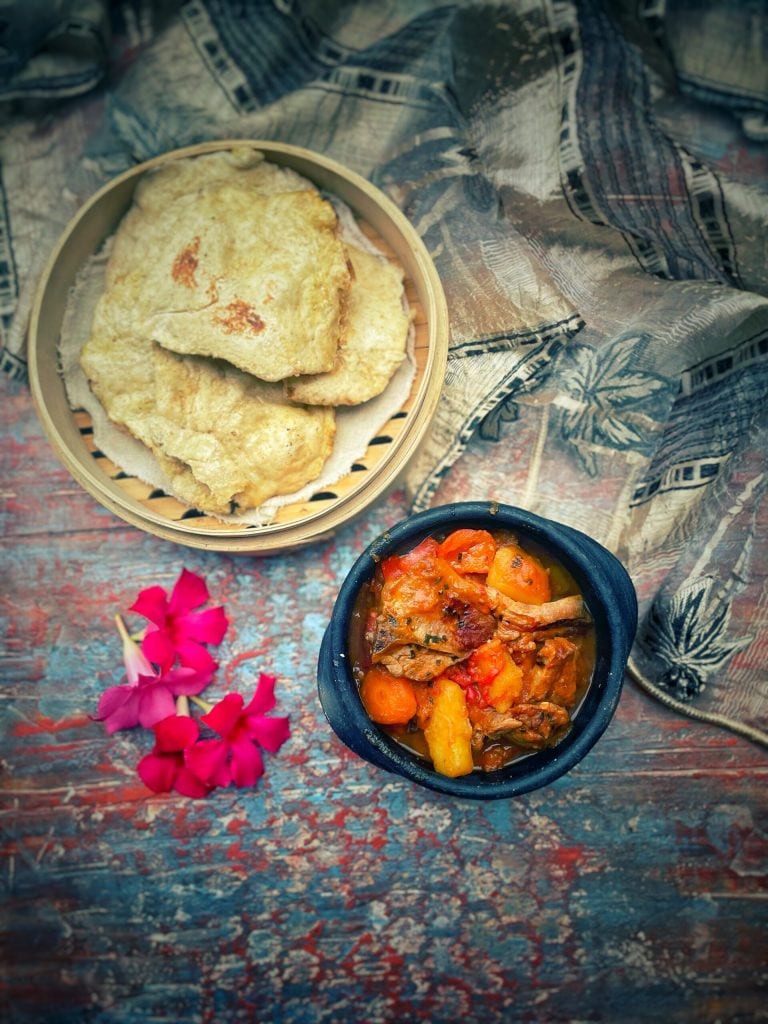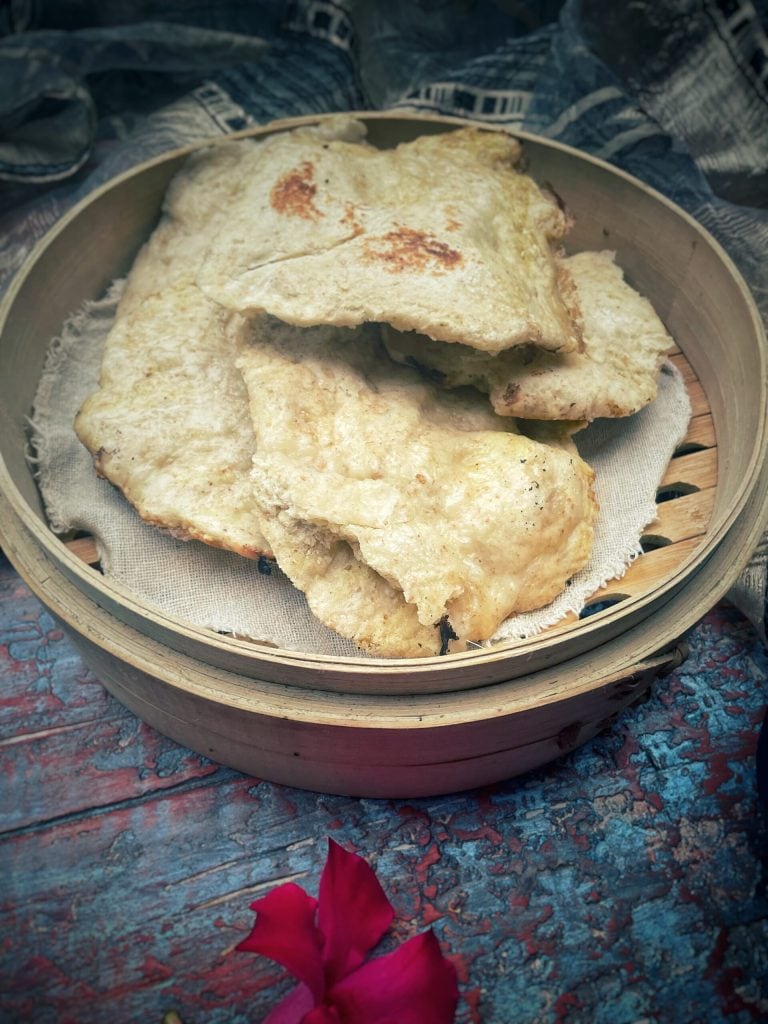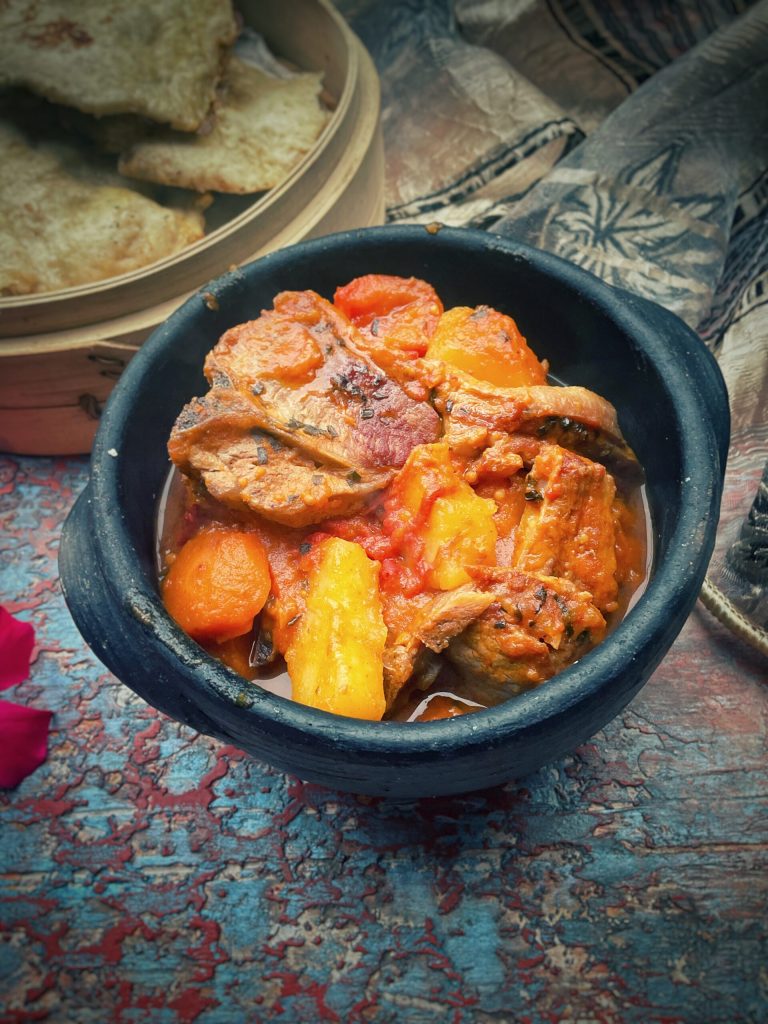Yapma (or Yapmanaan) is a traditional dish of Uyghur cuisine, originating from the Xinjiang region in China.
It is a rich and flavorful lamb stew, cooked with vegetables and served with naan bread.
It is a communal dish, often prepared for special occasions and shared among family and friends.
Since Uyghurs are Muslims and do not eat pork, the choice is limited to beef and mutton.
In Xinjiang, they consume nan or nang(馕), similar to the well-known Indian bread. Usually cooked in an oven called tonur and sold on the street.
In Turkic languages, such as Uzbek, Kazakh, or Uyghur, flatbread is known as nan, a word derived from Persian, which generally indicated bread.
Among the types of naan in Xinjiang are oil naan, corn naan, white peel naan, etc., and they are often decorated with spiral motifs and nigella seeds or sesame.
The bread that accompanies Yapmanan is baked in a tonur oven, easily replicable at home with a baking stone or a well-heated oven.
Other Uyghur recipes on the blog:

- Difficulty: Medium
- Cost: Medium
- Preparation time: 10 Minutes
- Portions: 4People
- Cooking methods: Boiling, Oven
- Cuisine: Chinese
- Seasonality: All seasons
Ingredients
- 4 cups flour
- 1 cup lukewarm water
- 0.25 oz dry yeast
- 2 tsp salt
- 11 oz lamb (chops)
- 2 cloves garlic
- 1 onion
- 2 carrots
- 1 yellow potato
- 1 sweet potato
- 4 tomatoes
- 2 bell peppers
- to taste vegetable broth
- to taste salt
Steps
Dough:
In a bowl, dissolve the yeast in a little lukewarm water with sugar (if used).
Add the flour and salt, then knead by gradually adding the water until you get a smooth and soft dough.
Cover and let rise for about 1 hour until doubled.
Divide the dough into 4 balls.
Roll each ball into a disk about 0.4 inches thick and 8 inches wide.
Make decorative holes in the center with a fork or a naan stamp (or simply press with your fingers).
Brush with a little water or oil and sprinkle with sesame or nigella.
Traditionally cooked in the tonur, but you can use a very hot oven (482°F) with a baking stone.
Bake for about 8-12 minutes until golden and well-cooked on the bottom.
If you want a shinier crust, you can brush it with oil at the end of cooking.
In a large pot, heat olive oil over medium heat.
Add the lamb and brown until golden.
Incorporate garlic and onion, cooking until translucent.
Add carrots, potatoes, peppers, and tomatoes.
Season with salt and mix well.
Cover the pot, add some broth, and let simmer for about 40 minutes, checking if more broth is needed during cooking.Arrange the stew in a large serving dish.
Accompany with naan bread, allowing guests to use it to scoop up the stew.
FAQ (Questions and Answers)
Who are the Uyghurs?
The Uyghurs are a Turkic ethnic group living primarily in the Xinjiang Uyghur Autonomous Region, in the northwestern part of China. They are known for their unique culture and language, influenced by Islamic traditions and Central Asian Turkic cultures.
The Uyghurs have a rich and complex history dating back over 4,000 years. Their culture is characterized by:
Uyghur language: a Turkic language spoken by the Uyghurs and written with the Arabic alphabet.
Islam: most Uyghurs are Sunni Muslims, and Islam plays an important role in their culture and daily life.
Traditions: Uyghurs have a rich tradition of music, dance, art, and literature.
Uyghurs face several challenges and issues, including:
Cultural repression: the Chinese government has imposed restrictions on religious freedom and the Uyghur culture, leading to a loss of cultural and linguistic identity.
Violence and repression: there have been episodes of violence and repression against the Uyghurs, leading to tension and instability in the region.
Reeducation camps: the Chinese government has established reeducation camps for Uyghurs, where they are subjected to a form of detention and “reeducation,” raising international concerns.
The situation of the Uyghurs is considered critical and has raised international concerns. Many countries and organizations have condemned the Chinese government’s actions against the Uyghurs and called for greater protection of human rights in the region.Does Chinese nan differ from Indian naan?
Yes, Chinese “nan” (馕, náng) and Indian “naan” are two different products, both in origin and preparation, although they share Persian etymology (nānn = bread).
Origin and dissemination
Indian naan: typical of South Asia, cooked in a tandoor. Soft, often brushed with butter or ghee.
Chinese nan (Uyghur naan or 新疆馕): typical of the Xinjiang autonomous region, of Uyghur origin and influenced by Central Asian culture.
Dough
Indian naan: contains yogurt and sometimes yeast, for a soft consistency.
Uyghur nan: simple dough with flour, water, yeast, and a little salt; more similar to a dry flatbread or pita.
Cooking
Indian naan: in the tandoor, at high temperature, remains soft.
Uyghur nan: baked in a tonur (clay dome oven); results in a drier and crispy outside, soft inside.
Shape and decoration
Indian naan: oval or teardrop-shaped, often plain or with garlic, cheese, etc.
Chinese nan: round, often decorated with spiral motifs, sesame seeds, or nigella in the center.

